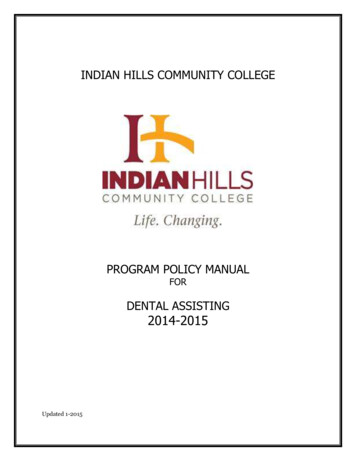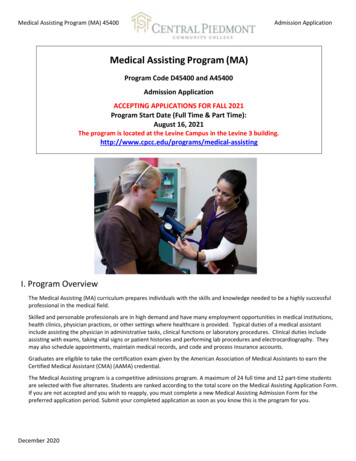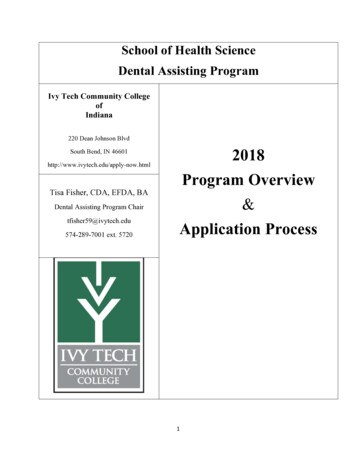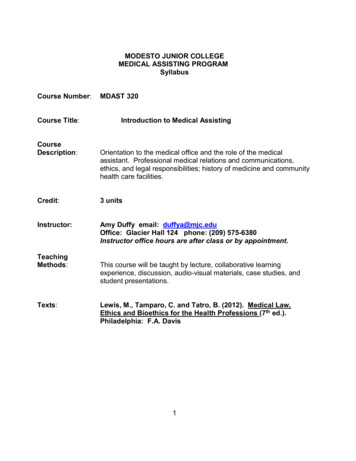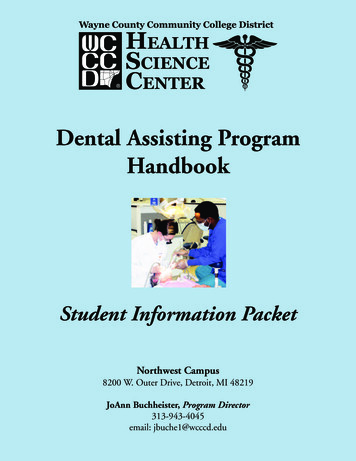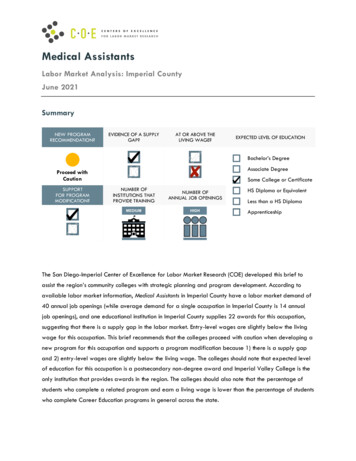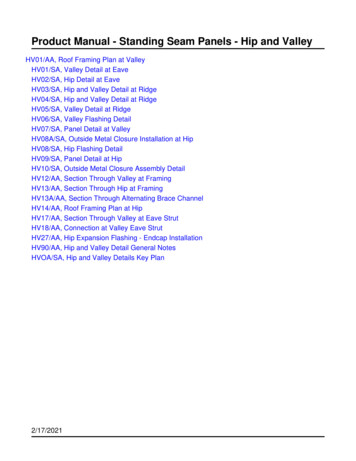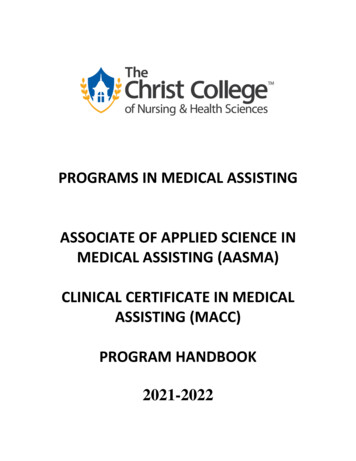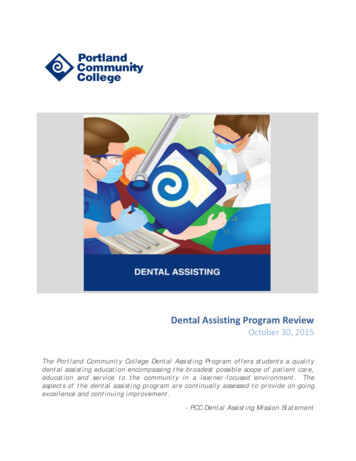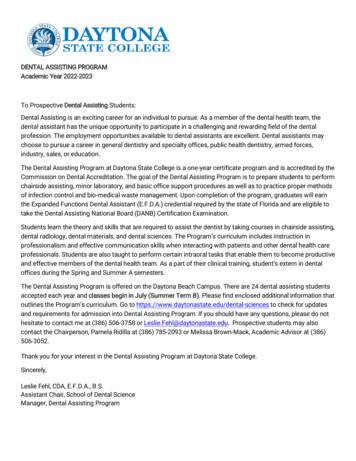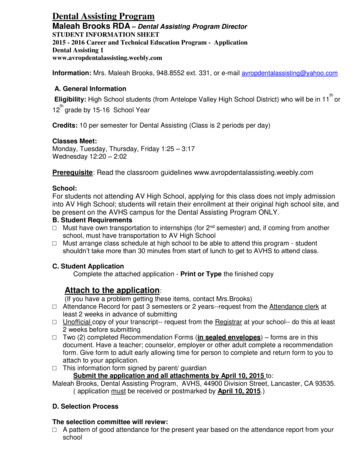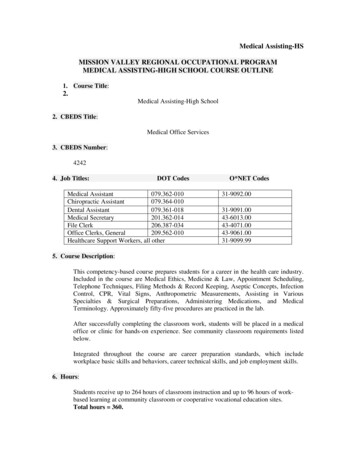
Transcription
Medical Assisting-HSMISSION VALLEY REGIONAL OCCUPATIONAL PROGRAMMEDICAL ASSISTING-HIGH SCHOOL COURSE OUTLINE1. Course Title:2.Medical Assisting-High School2. CBEDS Title:Medical Office Services3. CBEDS Number:42424. Job Titles:DOT CodesMedical Assistant079.362-010Chiropractic Assistant079.364-010Dental Assistant079.361-018Medical Secretary201.362-014File Clerk206.387-034Office Clerks, General209.562-010Healthcare Support Workers, all otherO*NET 61.0031-9099.995. Course Description:This competency-based course prepares students for a career in the health care industry.Included in the course are Medical Ethics, Medicine & Law, Appointment Scheduling,Telephone Techniques, Filing Methods & Record Keeping, Aseptic Concepts, InfectionControl, CPR, Vital Signs, Anthropometric Measurements, Assisting in VariousSpecialties & Surgical Preparations, Administering Medications, and MedicalTerminology. Approximately fifty-five procedures are practiced in the lab.After successfully completing the classroom work, students will be placed in a medicaloffice or clinic for hands-on experience. See community classroom requirements listedbelow.Integrated throughout the course are career preparation standards, which includeworkplace basic skills and behaviors, career technical skills, and job employment skills.6. Hours:Students receive up to 264 hours of classroom instruction and up to 96 hours of workbased learning at community classroom or cooperative vocational education sites.Total hours 360.
Medical Assisting-HS7. Prerequisites:Community Classroom requirements: All students must provide immunization recordsand proof of a negative TB test. A uniform and closed-toed shoes are required, astethoscope is also recommended. To be eligible, students need successful completion ofclass work at 75% or better and required hours, and transportation of second semesterclinical sites.8. Date of Revised and Approved:November 10, 2016Abbreviations:CC Community Classroom(unpaid, on-the-job, training experience at business sites)CVE Cooperative Vocational Education(paid, on-the-job, training experience at business sites)9. Course Outline:Upon successful completion of this course, students will be able to demonstrate the following skillsnecessary for entry-level employment.I.CAREER PREPARATION STANDARDSClassWORKPLACE BASIC SKILLS & BEHAVIORSIntegrated throughoutcourse(MVROP ESLR #1)A.B.C.D.E.Apply skills learned in class.1. read well enough to perform the tasks of a medical assistant2. write at an industry acceptable level3. correctly apply mathematics skills within the requirements ofthe industry4. accept criticism and modify actions appropriatelyAnalyze information and make decisions.Communicate verbally and in writing (see Unit VII.)Work independently and as a team member in a diverse workplace(See Unit VII.)1. demonstrate a positive attitude toward work2. describe sexual harassment & demonstrate measures to avoid it3. describe the consequences of sexual harassment4. adapt well to diverse personalities and changing responsibilities5. practice self-managementWork reliably, responsibly, and ethically.1. demonstrate appropriate behavior2. produce quality work and an increasing quantity of work3. receive a positive evaluation form the training site4. apply positive business and personal ethics and etiquette5. apply integrity & honesty in the classroom and the training siteCC/CVE
Medical Assisting-HSF.Demonstrate punctuality and good attendance in the classroom and atthe training site.1. maintain good grooming habits2. allocate time effectivelyClassII.CAREER TECHNICAL SKILLS(MVROP ESLR #2).A.B.C.D.III.Use appropriate technology to process information.Understand and practice occupational safety standards (see Unit XI)Demonstrate an awareness of how a business or industry functions.Describe the facility organization.JOB EMPLOYMENT SKILLS(MVROP ESLR #3)A.B.C.CC/CVEIntegrated throughoutcourseIntegrated throughoutcourseDevelop a plan to achieve career goals.Use effective job search strategies.1. prepare a resume and a cover letter2. use common resources to locate a job3. complete a job application4. practice successful interview techniques5. describe the customary benefits for an entry level employeeDemonstrate an awareness of the importance of lifelong learning.CONTENT AREA SKILLSIV.ClassCC/CVEIdentify ten career opportunities that are available to the trainedmedical assistant.Identify at least five general knowledge areas in which the medicalassistant should be proficient.Differentiate between administrative and clinical responsibilities of amedical assistant.List five personality traits that are beneficial to the successful medicalassistant.Describe the training programs that are available for medical assistants.Name four professional organizations that provide educationalopportunities and certification examinations.51MEDICAL ETHICS103INTRODUCTION TO MEDICAL ASSISTING(MVROP ESLR #2)A.B.C.D.E.F.V.(MVROP ESLR #2)A.B.C.D.Define and spell the terms listed in the vocabulary.Differentiate between the terms ethics and etiquette.Identify the earliest written code of ethical conduct for medicalpractice.Name the ancient Greek oath that remains an inspiration to physicianstoday.
Medical Assisting-HSE.F.G.H.I.J.VI.Identify a code that was an example for the AMA Principles of MedicalEthics.State a significant reason for the 1980 revision of the AMA Principles.State the maximum penalty that a medical society can impose on amember for unethical conduct.Discuss what and to whom information about a patient may bereleased.Discuss the application of ethics in dealing with fees and charges.Discuss the medical assistant’s ethical obligations and restrictions.MEDICINE AND THE LAWClassCC/CVE102208(MVROP ESLR #2)A.B.C.D.E.F.G.H.I.J.K.L.M.N.O.P.VII.Define and spell the terms listed in the vocabulary.State the purpose of medical practice acts and how they are established.List the three methods by which licensure may be granted.List the general categories of cause for revocation or suspension of alicense.Explain the difference between criminal and civil law.Define a contract and explain its importance in a healthcare facility.Outline the correct way for a physician to terminate the physicianpatient relationship.State the four “D's of Negligence” as published by the AmericanMedical Association.Describe the arbitration procedure, and identify three advantages.List the six components of informed consent.Explain the purpose of Good Samaritan Acts.State two restrictions imposed on physicians by the Anatomical GiftAct.Explain the medical assistant’s role in claims prevention.State the meaning of administrative law.Discuss the importance of compliance with OSHA regulations.Explain the essential difference between a living will and a durablepower of attorney.INTERPERSONAL SKILLS AND HUMAN RELATIONS(MVROP ESLR #2)A.B.C.D.E.F.G.H.I.Define and spell the terms listed in the vocabulary.State the factors that most influence the formation of a first impression.List three distinct steps in communicating with the patient.Name the three components of listening.List four possible barriers to communication.Briefly describe the paths of communication.List seven rules of good team cooperation.List and briefly describe the three styles of management.Explain the meaning of being a patient advocate.
Medical Assisting-HSVIII.ClassCC/CVEDefine and spell the terms in the vocabulary.Discuss the importance of telephone communications.List ways by which the medical assistant can develop a pleasingtelephone personality.Cite seven items to be included in taking a complete telephonemessage.Identify ten kinds of telephone calls that the medical assistant should beable to handle successfully.Identify six kinds of telephone calls that will need to be referred to thephysician for response.Explain what is involved in monitoring telephone calls.Explain what is meant by pre-planning a call.Explain the ways in which an operator-answered telephone answeringservice can benefit a medical practice.104APPOINTMENT SCHEDULING & TIME MANAGEMENT103156308TELEPHONE TECHNIQUES(MVROP ESLR #2)A.B.C.D.E.F.G.H.I.IX.(MVROP ESLR #2)A.B.C.D.E.F.G.H.I.J.X.Define and spell the terms listed in the vocabulary.Describe four important features of an appointment book.List and explain the three basic guidelines to follow in schedulingappointments.Identify and discuss the advantages of wave scheduling.Cite three common situations that would require adjusting theappointment schedule.Describe how you would determine whether a request for anappointment is an emergency.State the reason for recording a failed appointment in the patient’schart.Discuss the handling of cancellations and delays brought about byoffice situations.List the seven points of information that will be necessary in schedulingsurgery with a hospital.State four items of information that must be available before arrangingan outside laboratory appointment for a patient.FILING METHODS AND RECORD KEEPING(MVROP ESLR #2)A.B.C.D.E.XI.Define and spell the terms listed in the vocabulary.List and discuss the basic equipment and supplies in a filing system.Describe the seven sequential steps in filing a document.List and discuss application of the four basic filing systems.Explain how color coding of files can be advantageous in a healthcarefacility.ASEPTIC CONCEPTS AND INFECTION CONTROL
Medical Assisting-HS(MVROP ESLR #2)A.B.C.D.E.F.G.H.I.J.K.L.M.XII.Define and spell the terms in the vocabulary.Explain the five links in the chain of infection.Identify the eight specific reactions the body initiates as theinflammatory response.Differentiate among the four types of infections.Compare virus and bacteria cell invasion.List the infectious materials covered in the Standard Precautions.Identify the four major areas included in the OSHA ComplianceGuidelines.Differentiate between medical and surgical asepsis.Differentiate among sanitization, disinfection, and sterilization.Explain the types and uses of indicators.Discuss the legal and ethical concerns regarding medical asepsis andinfection control.List possible methods of patient education.Obtain CPR certification and demonstrate first aid procedures.VITAL SIGNS & ANTHROPOMETRIC MEASUREMENTSClassCC/CVE25102212(MVROP ESLR #2)A.B.C.D.E.F.G.H.I.J.K.L.M.N.XIII.Define and spell the words in the vocabulary.Cite the average values of body temperatures, pulse rates, respiratoryrates, and blood pressure.Describe how emotional and physical factors cause body temperature toincrease or decrease.Identify the 24-hour patterns for three types of fevers.List six methods for obtaining a patient’s temperature.Describe pulse rate, volume, and rhythm.List four important characteristics to note when taking a pulse.List six respiratory rate variations.Describe the best way to obtain accurate respiration counts.List four physiologic factors affecting blood pressure.Differentiate between essential and secondary hypertension.Describe the methods for obtaining weight and height of a patient.Identify patient education possibilities.Describe legal and ethical responsibilities in obtaining vital signs.ASSISTING WITH THE PRIMARY PHYSICALEXAMINATION(MVROP ESLR #2)A.B.C.D.E.Define and spell the words in the vocabulary.Describe the structural development of the human body.Identify the eleven body systems and the major organs or units in each.List ten instruments that may be used during a physical examination.Describe the six methods of examination and give an example for each.
Medical Assisting-HSF.G.H.I.J.XIV.Outline the basic principles of properly draping a patient forexamination.List eight positions that may be used in examinations.Outline the sequence of a routine physical examination.Identify the medical specialty for each body system.Discuss the legal and ethical implications of the physical examination.ASSISTING IN CARDIOVASCULAR MEDICINEClassCC/CVE103103103(MVROP ESLR #2)A.B.C.D.E.F.G.H.I.J.K.XV.Define and spell the terms in the vocabulary.Anatomically & physiologically describe the heart & its significantstructures.Identify the important presenting symptoms of cardiovascular disease.List the signs, symptoms, and diagnostic and therapeutic proceduresemployed with coronary artery disease and hypertension.Anatomically and physiologically describe the circulatory vessels.List the most frequently diagnosed vascular conditions.Trace the electrical conduction system through the heart.State the meaning of the horizontal and vertical lines on the ECG paper.List four types of common artifacts & explain the probable cause.Discuss the process of obtaining the ECG.Recognize the differences between patient preparation of the basicECG & the stress test.ASSISTING IN PULMONARY MEDICINE(MVROP ESLR #2)A.B.C.D.E.F.G.XVI.Name and locate the structures of the respiratory system.Describe the functioning purpose of each respiratory structure.Demonstrate understanding of ventilation.Identify the major categories of respiratory diseases.Differentiate the signs and symptoms and the diagnosis and treatmentfor the diseases discussed in this chapter.Assist the pulmonary physician in the examination of the chest &lungs.Spell and define the terms in the vocabulary.ASSISTING WITH OPHTHALMOLOGY ANDOTORHINOLARYNGOLOGY PROCEDURES(MVROP ESLR #2)A.B.C.D.E.F.Explain the differences among an ophthalmologist, optometrist, andoptician.Identify the anatomic structures of the eye.Describe how vision occurs.Differentiate among the four major types of refractive errors.Give four reasons each for eye irrigation and instillation of medication.Identify the structures and explain the functions of the external, middle,and internal ear.
Medical Assisting-HSG.H.I.J.K.L.XVII.List disorders that can cause hearing losses.Differentiate between conductive and sensory losses.Describe four methods used to assess hearing acuity.State three reasons for ear irrigations and/or instilling ear medication.State reasons for ensuring aseptic technique in both eye and earprocedures.Spell and define terms in the vocabulary.ASSISTING IN GASTROENTEROLOGY & PROCTOLOGYClassCC/CVE103103(MVROP ESLR #2)A.B.C.D.E.F.G.H.I.J.K.L.XVIII.Describe the three primary functions of the gastrointestinal system.Identify the major functions of the system and describe the physiologyof each phase.Name the six fundamental aspects of the gastrointestinal system.List eight diseases or disorders of the gastrointestinal system and thesigns, symptoms, methods of diagnosis, & treatment for each.Describe the significance of the gastrointestinal system and itsrelationship with other body systems.Define hepatitis and describe the similarities and differences of the fivetypes.Identify the methods used to diagnose gallstones.Identify the types of disorders that might be referred to a proctologist.List ten possible laboratory procedures that could be ordered to assistthe physician in obtaining a diagnosis.Explain the indication of a positive occult blood screening.List the types of laboratory samples that can be obtained during anendoscopic procedure.Spell and define the terms in the vocabulary.ASSISTING IN GYNECOLOGY AND OBSTETRICS(MVROP ESLR #2)A.B.C.D.E.F.G.H.I.J.K.Identify the major organs of the female reproductive system andexplain the primary function of each.Trace the ovum through the three phases of menstruation.Explain the physiology of pregnancy from conception through the threetrimesters and parturition.Identify the three types of pregnancy complications.List and explain the diseases and disorders that may affect the female.Name and describe seven sexually transmitted diseases.Outline the medical assistant’s role in the reproductive examination.Compare and contrast the yearly physical examination with the initialpregnancy examination.Name and describe the medical assistant’s role in seven diagnostic teststhat may be done in evaluating the female reproductive system.Define family planning and the three classifications of birth control thatare used.Spell and define terms in the vocabulary.
Medical Assisting-HSXIX.ASSISTING IN NEUROLOGYClassCC/CVE103103103103(MVROP ESLR #2)A.B.C.D.E.F.G.H.I.J.XX.Identify the anatomic structures that compose the nervous system.Explain the functions of the peripheral and central nervous systems.Differentiate between the different layers of the brain’s protectivecovering.Define a synapse.Name and describe the functions of the three major sections of thebrain.List the seven symptoms that suggest possible neurologic problems.Identify three brain disorders that result from injury.Name two disorders that could be work-related injuries.Identify the frequently used diagnostic procedure for nerve disorders.Define and spell vocabulary terms.ASSISTING IN DERMATOLOGY(MVROP ESLR #2)A.B.C.D.E.F.G.H.I.J.XXI.Identify the anatomic structures of the skin.Explain the major functions of the skin.Identify different lesions by name.List and describe types of thermal skin injuries.Name eight diseases or disorders of the skin.Discuss your role in assisting with dermatologic testing.Identify six forms of dermatologic medications.Analyze your role in patient education.Discuss legal issues in caring for the dermatologic patient.Define and spell vocabulary terms.ASSISTING IN ORTHOPEDIC MEDICINE(MVROP ESLR #2)A.B.C.D.E.F.G.H.I.J.XXII.Describe the principal structure of the musculoskeletal system.Identify five types of bones and give an example of each type.Describe three forms of muscles.Differentiate between tendons, bursae, and ligaments.List and describe the major disorders of the system.Describe the different types of fractures.Explain types of diagnostic procedures used.Describe four types of ambulatory devices.Explain the uses for cold applications.Define and spell vocabulary terms.ASSISTING IN UROLOGY AND MALE REPRODUCTION(MVROP ESLR #2)A.B.List the organs of the urinary system and explain the function of each.Explain the reason the urinary system has many opportunities for
Medical Assisting-HSC.D.E.F.G.H.I.J.K.XXIII.contracting diseases and disorders.Compare and contrast the diseases and disorders of the urinary system.Identify the primary signs and symptoms of urinary problems.List the radiologic procedures used to diagnose urinary disorders.List the organs included in male reproduction.Trace sperm through the male reproductive tract.Explain the cause and effects of prostate disorders.Compare the effects of sexually transmitted diseases in the male withthose in the female.Understand and demonstrate the medical assistant’s role in urology.Define and spell vocabulary terms.URINALYSISClassCC/CVE7460(MVROP ESLR #2)A.B.C.D.E.F.G.XXIV.Understand the purpose of routine urinalysis.State the five types of urine specimens used.Describe the physiology of urine formation.Describe the tests in the physical and chemical examination of urine.List five materials found in urine sediment microscopically.Define urinary quality control.Spell and define vocabulary terms.ADMINISTERING MEDICATIONS(MVROP ESLR #2)A.B.C.D.E.F.G.H.I.J.K.L.M.N.Spell and define the words listed in the vocabulary.List six factors of patient assessment that may influence whether youshould continue with an order to administer a drug.State two situations in which it may be your responsibility to furtherassess an ordered drug before administering it.State two environmental factors that would contraindicate theadministration of a medication.Recall the three befores and the six rights.List basic solid & liquid oral dosage forms & give an example of each.For each of the five mucous membrane sites, cite the methods foradministering medications.Differentiate among the nine types of topical medications.For each parenteral method, list the preferred needle gauges and lengthsand the usual syringe size.State the risks of using reusable injection equipment and threeadvantages of disposable injection equipment.List the contraindications for administering a parenteral drug in anyparticular site.Locate the anatomic landmarks for each intramuscular injection site.List the special considerations of anatomy when administeringinjectable medications to infants and small children.Recall the Centers for Disease Control and Prevention standards.
Medical Assisting-HSXXV.ClassCC/CVEDefine and spell the words in the vocabulary.Identify by name the instruments used in minor surgery procedures.Identify types of sutures and surgical needles.81ASSISTING WITH SURGICAL PROCEDURES6127288PREPARING FOR SURGERY(MVROP ESLR #2)A.B.C.XXVI.(MVROP ESLR #2)A.B.C.D.E.F.G.H.I.J.Transfer sterile instruments.Prepare a patient’s skin for minor surgery.Open a sterile linen pack.Open and add a sterile pack to a sterile field.Add sterile items in a peel-back wrapper to a sterile field.Assist with a minor surgical procedure.Assist with suturing.Assist with suture removal.Bandage the injured site.Define and spell vocabulary terms.HoursTotal Approved Course Hours36010. Additional Items:a. Articulation: This class is not articulated with any colleges at this time.b. UC/CSU A-G Status: This course meets the UC/CSU Area G-College Prep Electiverequirement.c. Instructional Strategies:lecturegroup discussionbrainstormingreading assignmentsoral reportsmulti-media/PowerPoint/videohands-on practicedemonstrationlaboratory assignmentsteamworkrole-playingsimulationsmall & large group activitiescomparative analysisinterviewscommunity or business observationsuse of business partnersd. Instructional Materials:Reference Textbooks:Kinn’s The Medical Assistant-Applied Learning Approach, Ninth Edition, 2003Diversified Health Occupations, Sixth Edition, 2004
Medical Assisting-HSMedical Terminology Express, Gylys and Masters, 2015Understanding Anatomy and Physiology, Thompson 2015handoutsarticleson-line tutorialsclass web sitesoftwarePowerPoint presentationsvisual overhead transparenciesvideo tapes/DVDInternet accesse. Certificate Competency List:American Heart Association Certificate for CPR/BLS.Students receive a MVROP Completion Certificate in Medical Assisting upon successfulcompletion of all units at 75% percent or better, fulfillment of the required number ofinstructional hours, and serve an ethical and successful internship at their Community Classroomsite.Content Area Skills: Identify Medical Ethics and the Application of ConductDiscuss Medical Practice, Licensure, Regulations, and the LawExplain the HIPAA standards as related to the MAHandle Appropriate Telephone Communication ExpectationsDescribe Methods for Appointment Scheduling and Time ManagementExplain Filing Methods and Record Keeping ConcernsDemonstrate Aseptic Procedure and Infection ControlComplete CPR Certification and First Aid ProceduresList Methods for Vital Signs and Anthropometric MeasurementsOutline Principles for Assisting with a Physical ExaminationDiscuss Assisting Requirements for Cardiovascular, Pulmonary, Ophthalmology,Otorhinolaryngology, Gastroenterology, Proctology, Gynecology, Obstetrics,Neurology, Dermatology, Orthopedic, Urology, and Reproductive Medicine Describe the Tests for Urinalysis State Factors of Administering Medications Prepare to Assist with Surgical Procedures
MISSION VALLEY REGIONAL OCCUPATIONAL PROGRAM MEDICAL ASSISTING-HIGH SCHOOL COURSE OUTLINE 1. Course Title: 2. Medical Assisting-High School 2. CBEDS Title: Medical Office Services 3. CBEDS Number: 4242 4. Job Titles: DOT Codes O*NET Codes Medical Assistant 079.362-010 31-9092.00 Chiropractic Assistant 079.364-010 Dental Assistant 079.361-018 31 .
